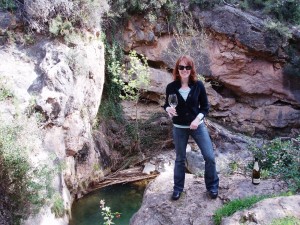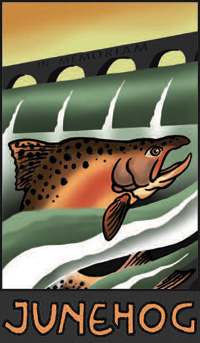Wondered where I've been? March was largely spent downtown or throughout Cambridge at various venues set up for trade folks to taste hundreds of wines, both those entirely new to market and also and equally important, newly released vintages of old friends. It was a more rigorous spring tasting season on "the circuit" (as we wine professionals call it) than last year, I hate to admit it.
Meanwhile, I was preparing for my trip (now in motion...) to Spain, where I have been visiting what I call Cava Country, more formally known as Penedes, and also the Priorat.
 My travels began a couple of days ago with Marc Picon at Pares Balta, which proved more than I could have imagined, even knowing in advance that this is a fourth-generation run estate that has embraced organic viticulture since The Beginning, well before it was of interest or marketable to do so. They also operate in what is now a national Park.
My travels began a couple of days ago with Marc Picon at Pares Balta, which proved more than I could have imagined, even knowing in advance that this is a fourth-generation run estate that has embraced organic viticulture since The Beginning, well before it was of interest or marketable to do so. They also operate in what is now a national Park.
When I arrived, Marc, my congenial on-sight host and the estate’s Export Manager, explained that Pares Balta's main priority isn’t showcasing the “music” behind their work in the winery when they are introducing people to Pares Balta (and yes, they make many, many different wines); rather they are focused on the land. I smiled and nodded a bit when he said this, because if you’ve taken a trip to any winery worldwide, I’m sure you, too, have heard the owner, winemaker or staff talk about the importance of terroir. Not to undermine their work or the sincerity of these statements, but I have to say, Pares Balta really does relish the earth and the natural course of things in an extreme way (and the result is extremely tasty!).
To explain better, Marc and I jumped in his SUV and began our “15 minute” journey up into the mountains where the Pares Balta vineyards are located, as I mentioned, now in a National Park. Yes, it is that serious. And yes, the ride was even more colorful than one of those Super Bowl SUV ads where you see trucks bouncing along easily over fallen logs, up cliffs and over boulders. If I could have taken a picture of it, I would have – but we were literally bouncing too much for me to capture the moment and video would have made any viewer nauseous.
Our first “stop” up the vigorous terrain was to the Pares Balta beehives. A costly undertaking, no doubt, PB has a beekeeper on staff to further support cross-pollination of the vines of course, but not just so they flourish; rather, so that the entire community flourishes, imparting natural, enhanced flavors in the wine. For example, the rosemary bushes growing alongside the trail flower. This flavor profile is gently communicated to the vines as the bees carry out their natural work. Brilliant. Nature helping nature help us.
 Marc employed a terrific approach to best share both the Pares Balta way and what makes Penendes unique. We didn’t just bound up the mountain and look out the window. Instead, we stopped at various, specific vineyard sites to taste certain wines alongside the river in one case, and at the top of the mountain, in another. At each stop you could literally feel the change in climate, the quality of “freshness” in the air, the amount of (or lack of) wind, etc.. What makes Penendes so special was poignant and palpable: the varied terrain (a vivid mix of plots of clay literally across the path from plots of chalk) and microclimates.
Marc employed a terrific approach to best share both the Pares Balta way and what makes Penendes unique. We didn’t just bound up the mountain and look out the window. Instead, we stopped at various, specific vineyard sites to taste certain wines alongside the river in one case, and at the top of the mountain, in another. At each stop you could literally feel the change in climate, the quality of “freshness” in the air, the amount of (or lack of) wind, etc.. What makes Penendes so special was poignant and palpable: the varied terrain (a vivid mix of plots of clay literally across the path from plots of chalk) and microclimates.
What was perhaps most compelling to me was the hands off/hands on approach PB employs. They fully embrace what nature delivers on its own, and yet they don’t hesitate to employ (or encourage nature along?) either. Case in point, they use pheromones at the edge of the vineyards site as a natural ‘turn off’ to butterflies (the wind carries the "off-putting" scent down the rows), encouraging them to go ‘play’ in someone else’s vineyards. It’s one way to avoid pesticides and let the fruit mature unhindered by pests.
Tasting through many of Pares Balta’s wines was its own experience. Their range is from traditional Cavas, to rare single varietal bottlings that capture both the essence of the grape and also, critically and as expected, of the vineyard site’s terroir and aspect. As a case in point, Marc enthusiastically offered me a tasting of one of their rarest wines, a dry Gewurtztraminer. It was possibly the most varietally expressive Gewurtz I have ever experienced. (Yes! This grape is incredibly rare to Spain and more often found in Europe’s Germany and Alsace; the spice in the wine literally poked at my taste buds! But no, their production is ever-so-small, and therefore will never reach our New England shores.)
In addition, Marc enthusiastically designed a taste-off between two pairs of wines. The first was of two Garnacha’s from two different vineyard sites. Their flavors were of like family, but certainly of distinct breeding: 2008 Hisenda Miret, a more rugged, gamey beast that tamed willingy as it opened; and the 2008 Indigena, a fruit forward, approachable Garnacha with the flare of a rosey-cheeked flamenco dancer.
The second taste-off was between two Tempranillos hailing from two different clones, one wine was made from the local Penendes grape Ull de Lebre, and the other from a Pares Balta project in a much farther region, Ribera del Duero. The Absis is a Tempranillo-based wine that delivered a surprising helping of stewed plumbs, golden raisin, orange rind, blackberry and brighter raspberry fruits, with intense herbs and purple flowers, while the Ribera wine showed more masculine muscle, wet soil, fine dried herbs and baker’s chocolate flavors.
Long story short, I could have stayed all day! But appointments in the equally world-reknowned Priorat region beckoned….






 White wines aren't just a summer thang. (One of the best turkey wines is actually
White wines aren't just a summer thang. (One of the best turkey wines is actually